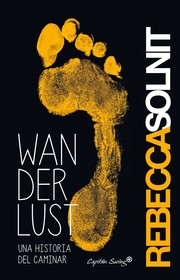Check nearby libraries
Buy this book

Un fascinante retrato de la infinita gama de posibilidades que se presentan a pie. Analizando temas que van desde la evolución anatómica hasta el diseño de las ciudades, pasando por las cintas de correr, los clubes de senderismo y las costumbres sexuales, Solnit sostiene que las diferentes variantes del desplazamiento pedestre —incluido caminar por placer— suponen una acción política, estética y de gran significado social. Para ello se centra en los caminantes más significativos de la historia y de la narrativa, cuyos actos extremos y cotidianos han dado forma a nuestra cultura: filósofos, poetas, montañeros... De Wordsworth a Gary Snyder, de Jane Austen a Elizabeth Bennet y Andre Breton, existe una larga asociación histórica entre caminar y filosofar.
La evidencia fósil de la evolución humana señala que la capacidad de moverse en posición vertical, sobre dos patas, es la que distinguió a los humanos de las otras bestias y la que nos permitió dominarlas. Para la autora, hay una clara relación entre el caminar y el pensamiento. Caminar —dice Solnit— es el estado en el que la mente, el cuerpo y el mundo están alineados. Wanderlust reproduce, en la sencillez y cadencias de su prosa, los ritmos de un buen paseo.
Check nearby libraries
Buy this book

Previews available in: English
Showing 6 featured editions. View all 13 editions?
| Edition | Availability |
|---|---|
|
1
Wanderlust: Una historia del caminar
2015, Capitán Swing, Capitán Swing Libros
Paperback
in Spanish
- 1st edition
8494367609 9788494367601
|
aaaa
|
| 2 |
eeee
|
| 3 |
eeee
|
| 4 |
eeee
|
| 5 |
eeee
|
| 6 |
eeee
|
Book Details
Edition Notes
Contributors
The Physical Object
Edition Identifiers
Work Identifiers
First Sentence
"Where does it start?"
Work Description
"In Wanderlust: A History of Walking, Rebecca Solnit draws together many histories -- of anatomical evolution and city design, of treadmills and labyrinths, of walking clubs and sexual mores -- to create a portrait of the range of possibilities for this most basic act. Arguing that walking as history signifies walking for pleasure and for political, aesthetic, and social meaning, Solnit hones in on the walkers whose everyday and extreme acts have shaped our culture, from the peripatetic philosophers of ancient Greece to the poets of the Romantic Age, from the perambulations of the Surrealists to the ascents of the mountaineers." "Solnit's book finds a profound relationship between walking and thinking, walking and culture, and argues for the necessity of preserving the time and space in which to walk in an evermore automobile-dependent and accelerated world. Book jacket."--BOOK JACKET.
Community Reviews (0)
History
- Created March 15, 2015
- 7 revisions
Wikipedia citation
×CloseCopy and paste this code into your Wikipedia page. Need help?
| March 16, 2023 | Edited by ImportBot | import existing book |
| February 21, 2020 | Edited by dcapillae | Moved edition to primary work |
| September 22, 2016 | Edited by dcapillae | Fix title |
| October 19, 2015 | Edited by dcapillae | Edited without comment. |
| March 15, 2015 | Created by dcapillae | Added new book. |


















